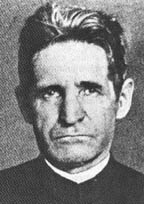JANUARY 8, 2023 – Movies, filled with dramatic distortions, embellishments and exaggerations, are often an unreliable source of historical information. Just as often, however, despite the lack of factual reliability, a film will stir the viewer’s curiosity and prompt further investigation of the historical record.
That was the case when I stumbled across the 2014 film, Pater Rupert Mayer, directed by Damian Chopra. I’d never heard of Father Mayer, a anti-Nazi Catholic priest/philosopher/violinist/former army chaplain—awarded the Iron Cross for bravery under fire in WW I; he lost a leg in that conflagration. This stoic, humane priest at St. Michael’s in Munich was born in Stuttgart and educated in Freiburg, Switzerland and Munich and Türbingen in Germany. If the film has its production flaws—most grating being the multiple scenes featuring absolutely horridly ignorant treatment of the violin—the over-arching take-away was positive: despite Catholicism’s sketchy, acquiescent record during the Nazi era, here was a priest who stood up to the authorities in no uncertain terms and walked the talk of his religious beliefs. In my post-screening “investigation of the historical record,” I concluded that in its essential elements, the movie was unusually accurate.
The film ventured beyond dramatization of historical facts. In my case, at least, the work triggered a disturbing question: if I’d found myself in such fear-filled circumstances as the priest—or his parishioners—how would I have responded to Gestapo threats or Schutzstaffel (“SS”) brutality? Would I have risked my life, the security of my family by standing up to evil? Would I resist now in different times and a faraway place but under similar circumstances? Unless—and God forbid, until—I’m staring at a pistol pointed at me by a cruel, heartless, soulless equivalent of an SS brute or Gestapo agent, I can’t know for certain, how I’d react. What I can do, however, is keep myself fit—morally, ethically, intellectually, psychologically—to heighten the probability that if face-to-face with evil, I’d react the way I should according to my compasses undisturbed by an immediate mortal threat.
The film is effective in a related respect: it forces the viewer to ask what confluences cause beastly cruelty by an armed barbarian against a defenseless human. Attenuated fear? Lust for power? The spell of lies? Taking an irreversible step down a slippery slope? Or just plain evil in place of heart and soul? In the case of each Nazi depicted in Pater Rupert Mayer, I imagined an attempted psychological inquiry: “What makes you so cruel? What is at the root of your fear, your hatred, your anger, your insecurity? And . . . what would your doting grandma think . . . unless you weren’t fortunate enough to have and know one?” In each case, I surmised the most likely truth. The uniformed savage had blocked or extinguished all doubt, shame, guilt. In nearly all cases, no amount of appeal or argument could’ve altered the outcome. Only force or the inevitable outcome of evil—its self-consumption—could end the horror. I understood better that while I detest war and violence, I couldn’t be a “pacifist under any and all circumstances.”
Now a few notes on the violin . . . Numerous scenes show Father Mayer playing his violin. A glaring flaw of the film is how awfully ignorant these clips were mismanaged*. The apparent attempts at classiness were cringeworthy.
But I got over it. The essence of the film was edifying. Depiction of Father’s exceptional life and courage was inspirational.
*In the first place, it’s impossible to “sound-synch” a stringed instrument in a film. Piano? Easy—you simply film the actor at the keyboard but keep the actor’s hands and keyboard out of the frame—or film only the hands and keyboard of an actual pianist sitting in for the actor. But under no circumstances do you hand a bow and fiddle to an actor who—apparently—has never attended a concert featuring stringed instruments and quite probably never even set eyes on a violin, cello or bass. God but it was atrocious. The actor (Oliver Gruber) gripped the neck of the instrument as if it were an ax handle. He held the bow like a caveman holding a club and moved it in a chop-chop fashion for music sounding legato. But the worst offense? The fiddle (the cheapest looking student model you could retrieve from a junk shop) had no bridge! The treatment of the violin in this film was as bad as casting actors in full hockey gear for extended scenes featuring a baseball game.
(Remember to subscribe to this blog and receive notifications of new posts by email.)
© 2023 by Eric Nilsson
